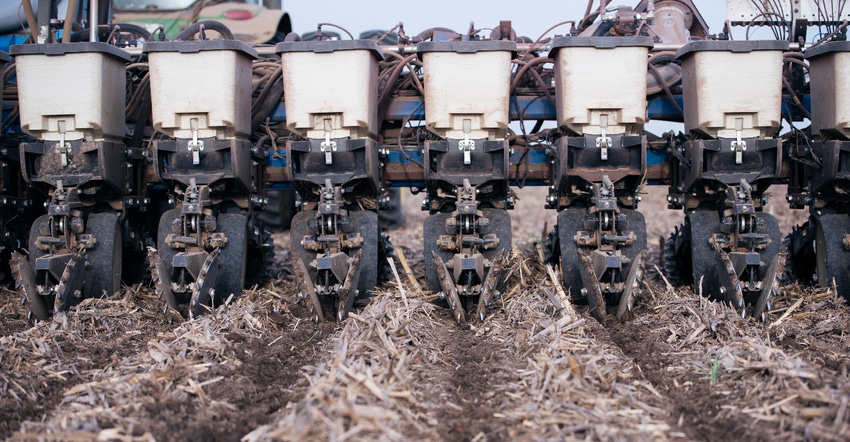
While Pennsylvania hasn’t done a custom farming rate survey since 2016, Maryland, New York and Ohio have recently updated their custom rate charts — giving farmers a sense of what they might have to pay for custom work this year.
Michigan will be updating its rate guide this spring, but for this story, the 2019 rates were shared.
Maryland’s rates are based off a fall 2020 survey sent to custom operators and farmers. They were collected from 55 respondents.
The overall cost of custom spring planting fell 11% to $18.31 an acre, compared to $20.38 an acre in 2019. Grass and hay production fell 29% to $12.32 an acre, while harvesting costs fell 2% to $71.30 an acre.
Custom labor costs rose 20% to $40.38 an acre, while custom equipment expenses are up 12% to $71.23 an acre.
Here are some highlights compared to 2019:
vertical tillage: $18.80 an acre, up 2.45%
corn planting, conventional with fertilizer: $17.92 an acre, down 24.5%
corn planting, conventional without fertilizer: $16.63 an acre, down 16.7%
corn planting, no-till with fertilizer: $21.54 an acre, up 0.9%
corn planting, no-till without fertilizer: $20.75 an acre, down 1.51%
conventional soybean planting: $20.04 an acre, down 4.11%
no-till soybean planting: $20.33 an acre, down 2.63%.
Empire State custom rates
Custom rates for farmers in New York can be hard to find, but Cornell Extension Franklin County does an annual survey of rates and fees that includes custom labor costs, rental rate fees for land and buildings, and tractor rates.
Here are some highlights:
corn planting: $23 an acre, no-till corn $25 an acre
manure spreading: $75 to $100 an hour
silage chopping, self-propelled: $270 an hour
corn combining: $42 an acre
small grain combining: $35 an acre
soybean combining: $40 an acre
Buckeye state rates
Ohio’s new report for custom rates is based on a statewide survey of 377 farmers, custom operators, farm managers and landowners conducted in 2020. These rates include the implement and tractor if required; all variable machinery costs such as fuel, oil, lube, twine, etc.; and labor.
The report says to consider large movements in fuel prices. The average price of retail-on-highway diesel in 2019, according the U.S. Energy Information Administration, was $3.056 per gallon.
The price of diesel fuel at the beginning of the survey period was $2.50 per gallon for off-road (farm) usage, and the price of off-road (farm) diesel toward the end of the survey period was $2 per gallon.
For custom farming, including all machinery operations for tillage, planting, spraying tending and harvesting, the average rate is $118 for corn, $103 for soybeans and $108 for small grains.
Here are some other highlights. Harvest price includes combine, grain cart and hauling. Prices are per acre:
strip tillage: $23.70
field cultivator: $14.50
fertilizer spread dry/bulk: $7
fertilizer liquid knife: $11.30
fertilizer anhydrous: $15.20
spraying self-propelled: $7.70
weed control conventional cultivation: $11.30
corn planting, conventional: $20
soybean planting: $20.10
small grains planting: $17.30
corn harvest: $33.90
soybean and wheat harvest: $31.50
manure spread: $13
Custom rates for Michigan
The most current custom rate information for Michigan is from Michigan State University’s 2019 Custom Machine and Work Rate Estimates, compiled by Bob Battel, MSU field crops educator.
Rates in different areas of Michigan may be higher or lower than the state average depending upon several factors, notes Ned Birkley, an MSU Extension educator emeritus and owner of Spartan Ag.
“Factors influencing custom machine work can include field size and shape, ease of access, amount of non-farm traffic to get to the field, machine size, width of roads or bridges, trash, weeds, trees or brush hindering work in the field, depth of field drainage tile, payment arrangements and other factors,” Birkley says.
Charging by the acre is not the only option. “Years ago, I did custom combining for a large acreage farmer who had three combines and hired two others," Birkley says. "You couldn't charge a per-acre rate as all five machines were working together. So, I charged him $90 per tach hour and everyone was happy.”
Here are some highlights. Soybean and corn harvest prices include combine, cart and hauling to storage:
chisel plow: $15.74
vertical tillage: $14.55
field cultivator: $12.87
corn planting, conventional: $18.98
soybean planting, conventional: $17.14
sugarbeet planting (12 rows): $32.50
sugarbeet self-propelled harvest and cart: $154
corn harvest: $41.57
soybean harvest: $38.83
fertilizer spreading dry/bulk: $5.22
fertilizer knived in: $11.05
fertilizer sidedressed: $10.93
Advice for shopping around
For Maryland, the rates include charges for machines, power, fuel, lube and labor/operator. They don’t include the costs of chemicals, seeds and other materials except for hay baling materials and where noted (i.e. spreading lime).
Custom rate guides are useful, but they should only be used as a guide, says Andrew Frankenfield, Penn State Extension educator.
“Actual custom rates may vary according to availability of machinery in a given area, timeliness, operator skill, field size and shape, crop conditions, and the performance characteristics of the machine being used,” he says.
“When we survey, we send to businesses that do custom operations but also to farmers that pay for custom activities. We have a mailing list that gets updated, and for the past two surveys, we have put out an online link and press releases,” says Shannon Dill, Extension educator with University of Maryland. “Rates are definitely dependent on your location, competitors and size of the job. Calling around for pricing can be helpful, but I mostly see that a relationship is built and most will continue that year in and year out, such as custom harvesting. If it is a new practice, local recommendations and word of mouth is also great.”
About the Author(s)
You May Also Like








